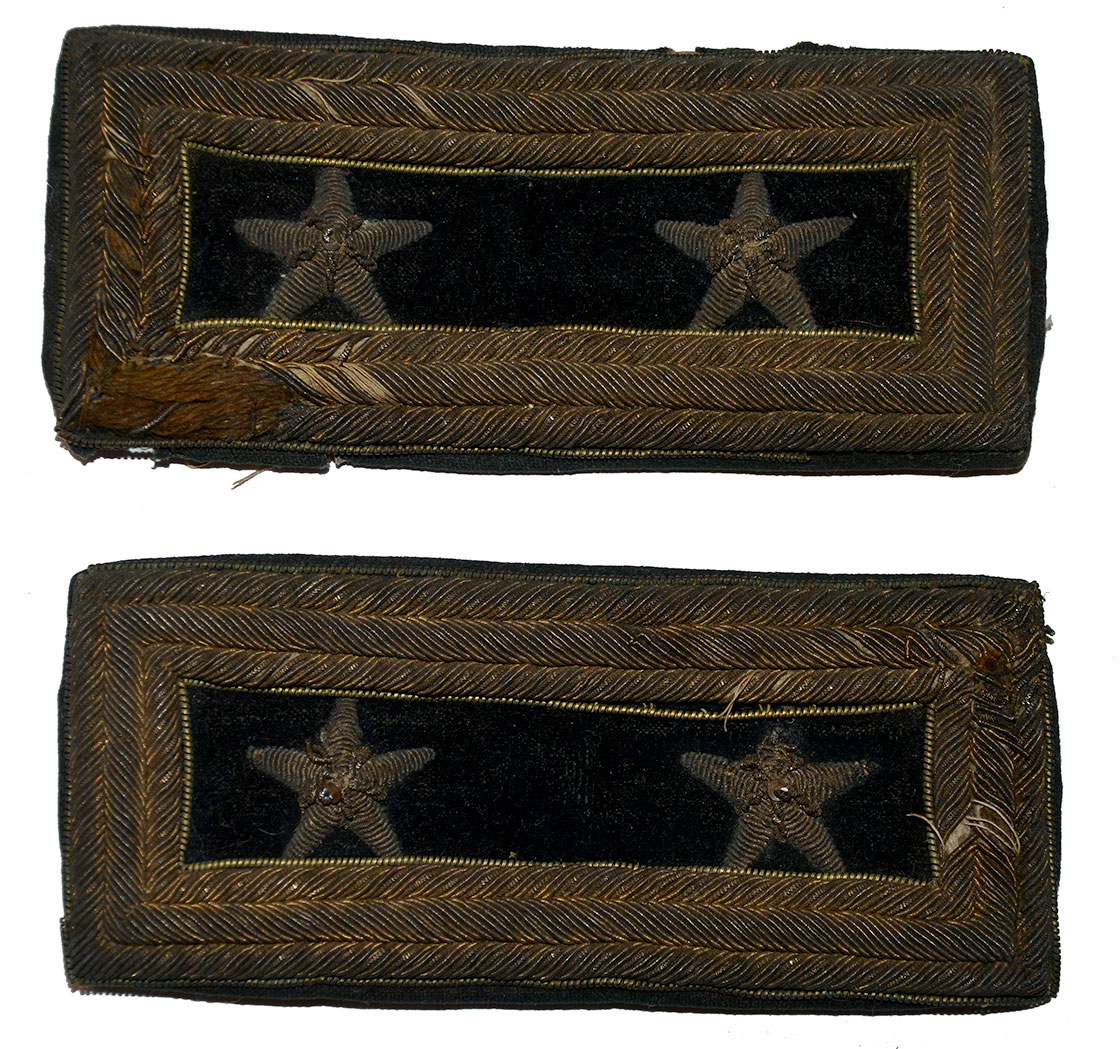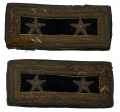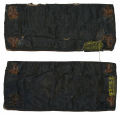site search
online catalog
TRIPLE-BORDERED BULLION EMBROIDERED MAJOR GENERAL’S SHOULDER STRAPS OF ABNER DOUBLEDAY: LED THE FIRST CORPS AFTER REYNOLD’S DEATH ON JULY 1

$6,950.00 ON HOLD
Quantity Available: 1
Item Code: 1255-02
Once in the personal collection of renowned military artist and historian Don Troiani, these major-general’s straps were worn by General Abner Doubleday. They are in good condition, showing some use and actual field-wear indicating they were not relegated to his baggage or confined to a full-dress uniform. The borders are constructed of three raised rows of bullion: two of alternating “dead and bright” bullion, with a single, slightly wider row of dull bullion running in the other direction in the middle. Two silver bullion embroidered stars are in place on the black velvet ground of both straps. The jaceron wire borders along the inner and outer edges are in place. The straps measure 4-3/4” long and 2” wide. The borders are ¾” wide. The stars fill the entire width of the black ground and are 1” tall. The black ground is very good on both straps. The silver bullion stars are good, though like the borders they show muting to the color from oxidation and wear to the high points, with loss to a point of one star and some missing strands to bullion ties that cross from inner corner to inner corner of each.
On one strap the borders show two places on one long edge where a couple of the strands in the center row are missing their bullion. On the opposite side the middle row shows loss of bullion to two sections of three or four strands each on the middle row, with the outer two rows showing loss of the bullion strands and exposure of the light brown cording underneath for about ¾” at the corner, with some of the light brown cording exposed in the center row of the adjacent short edge or side. On the other strap there are just a couple sections of narrow loss of bullion from strands in the inner row on one long side and two or three on the inner and middle rows of the adjacent short side. The inner jaceron wire shows a narrow gap along the edge and there is a small bit of loss to the point of one star on the opposite side of the same end of the strap.
The straps were certainly on a coat for a long time and much of the wear is clearly from natural handling and wear in the field. Both straps have their black, polished cotton backs intact and with small, doubled-wire hooks showing rust in place for mounting on the shoulders. Each strap has a matching small 4-digit collection number in black on a yellowish rectangle on one edge.
Born in 1819, Doubleday graduated 24th in the West Point class of 1842, the same class as James Longstreet and some other Confederate notables. He was assigned first as a brevet 2nd Lieutenant to the 3rd Artillery on July 1, 1842, and then as regular 2nd Lieutenant in the 1st Artillery on Feb. 24, 1845, followed by promotion to 1st Lieutenant on March 3, 1847. He served in Mexico but had to wait for promotion to Captain until March 3, 1855. He was witness to the outbreak of the war, serving in the garrison of Fort Sumter in April 1861 and published an account of his experience in 1876.
He was subsequently promoted Major of the 17th US Infantry on May 14, 1861, and served in the Shenandoah before being promoted Brigadier General of Volunteers Feb. 3, 1862. He commanded a brigade in McDowell’s Corps in the Campaign of Second Manassas, and was given a First Corps division command in the Antietam and Fredericksburg Campaigns, being promoted to Major General of Volunteers November 29, 1862, and serving at that rank until honorably mustered out of the volunteer service August 24, 1865.
He could have worn these straps at Fredericksburg, where he was part of the Left Grand Division, in the Chancellorsville Campaign, where the corps was first posted in front of Fredericksburg with Sedgwick’s forces, but then marched to join Hooker and hold the right of his line on May 3. More significantly, he could have worn them here are Gettysburg, where he commanded the First Corps after Reynolds was killed early in the infantry fighting on July 1, and conducted a creditable defense for several hours against superior Confederate forces. Meade replaced him as corps commander on the evening of July 1, something he attributed at least in part to an erroneous early message from Howard that the corps was retreating in disorder. Howard, himself, was also replaced with Hancock as commander on the field by Meade, so there was likely more than one dissatisfied party, and it seems Doubleday may have squared accounts with Congressional testimony critical of Meade. In any case, he remained on the field in division command and took an active part in subsequent fighting and was wounded in the neck on July 2. He published an account of the battle (along with Chancellorsville) as part of the “Campaigns of the Civil War” series in 1882.
Doubleday’s Civil War served the rest of war on administrative posts, but was given several promotions in his regular army ranking and also several brevets. He was breveted Lt. Colonel for gallant and meritorious service at Antietam as of Sept. 17, 1862; a regular appointment as Lt. Colonel of the 17th Infantry as of Sept. 20, 1863, and a brevet to full Colonel for gallant and meritorious service at Gettysburg dating to July 2, 1863; promotion to full Colonel of the 35th Infantry on Sept. 15, 1867, with additional brevets to brigadier general and major general as of March 13, 1865 for gallant and meritorious service during the war. He retired Dec. 11, 1873, died in New Jersey in 1893 and was buried at Arlington.
We include a signed letter from Don Troiani on his ownership of the straps. [sr][ph:L]
~~~~~~~~~~~~~~~~~~~~~~~~~~~~~~~~~~~
THIS ITEM, AS WITH ALL OTHER ITEMS AVAILABLE ON OUR WEB SITE,
MAY BE PURCHASED THROUGH OUR LAYAWAY PROGRAM.
CLICK HERE FOR OUR POLICIES AND TERMS.
THANK YOU!
Inquire About TRIPLE-BORDERED BULLION EMBROIDERED MAJOR GENERAL’S SHOULDER STRAPS OF ABNER DOUBLEDAY: LED THE FIRST CORPS AFTER REYNOLD’S DEATH ON JULY 1
For inquiries, please email us at [email protected]
Most Popular
Historical Firearms Stolen From The National Civil War Museum In Harrisburg, Pa »
Theft From Gravesite Of Gen. John Reynolds »
Selection Of Unframed Prints By Don Troiani »
Fine Condition Brass Infantry Bugle Insignia »
British Imported, Confederate Used Bayonet »
Scarce New Model 1865 Sharps Still In Percussion Near Factory New »
featured item
JOHN GOODE GETTYSURG DESK SET
The set consists of a rectangular block of wood sawn on the battlefield and mounted with square, cut glass inkwell at center with a wood top, which is surrounded in turn by relics from the battlefield: a Union officer’s Infantry-I button, a plain… (2024-1278). Learn More »
site search
Upcoming Events
APRIL 12-13: SPRING GETTYSBURG MILITARY ANTIQUES SHOW; All Star Events Complex Learn More »






